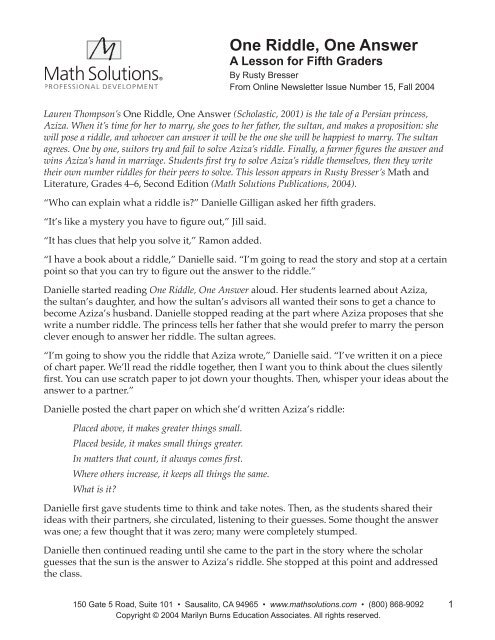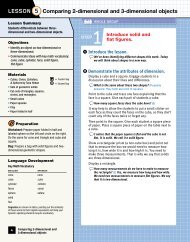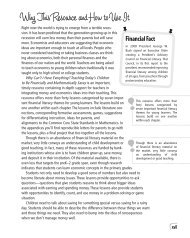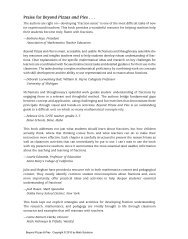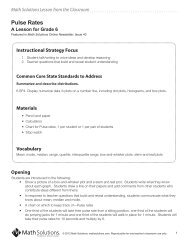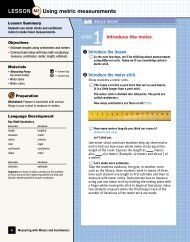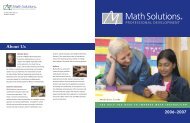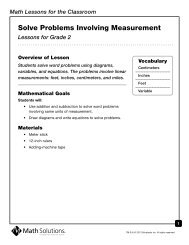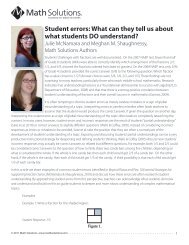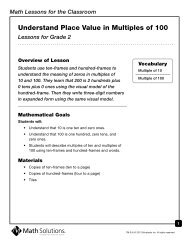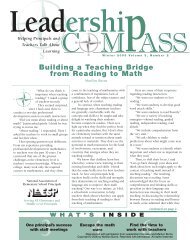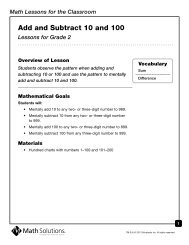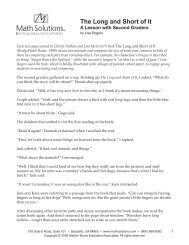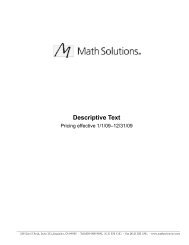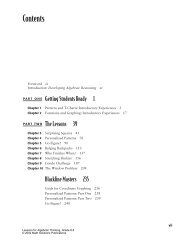One Riddle, One Answer - Math Solutions
One Riddle, One Answer - Math Solutions
One Riddle, One Answer - Math Solutions
Create successful ePaper yourself
Turn your PDF publications into a flip-book with our unique Google optimized e-Paper software.
<strong>One</strong> <strong>Riddle</strong>, <strong>One</strong> <strong>Answer</strong><br />
A Lesson for Fifth Graders<br />
By Rusty Bresser<br />
From Online Newsletter Issue Number 15, Fall 2004<br />
Lauren Thompson’s <strong>One</strong> <strong>Riddle</strong>, <strong>One</strong> <strong>Answer</strong> (Scholastic, 2001) is the tale of a Persian princess,<br />
Aziza. When it’s time for her to marry, she goes to her father, the sultan, and makes a proposition: she<br />
will pose a riddle, and whoever can answer it will be the one she will be happiest to marry. The sultan<br />
agrees. <strong>One</strong> by one, suitors try and fail to solve Aziza’s riddle. Finally, a farmer figures the answer and<br />
wins Aziza’s hand in marriage. Students first try to solve Aziza’s riddle themselves, then they write<br />
their own number riddles for their peers to solve. This lesson appears in Rusty Bresser’s <strong>Math</strong> and<br />
Literature, Grades 4–6, Second Edition (<strong>Math</strong> <strong>Solutions</strong> Publications, 2004).<br />
“Who can explain what a riddle is?” Danielle Gilligan asked her fifth graders.<br />
“It’s like a mystery you have to figure out,” Jill said.<br />
“It has clues that help you solve it,” Ramon added.<br />
“I have a book about a riddle,” Danielle said. “I’m going to read the story and stop at a certain<br />
point so that you can try to figure out the answer to the riddle.”<br />
Danielle started reading <strong>One</strong> <strong>Riddle</strong>, <strong>One</strong> <strong>Answer</strong> aloud. Her students learned about Aziza,<br />
the sultan’s daughter, and how the sultan’s advisors all wanted their sons to get a chance to<br />
become Aziza’s husband. Danielle stopped reading at the part where Aziza proposes that she<br />
write a number riddle. The princess tells her father that she would prefer to marry the person<br />
clever enough to answer her riddle. The sultan agrees.<br />
“I’m going to show you the riddle that Aziza wrote,” Danielle said. “I’ve written it on a piece<br />
of chart paper. We’ll read the riddle together, then I want you to think about the clues silently<br />
first. You can use scratch paper to jot down your thoughts. Then, whisper your ideas about the<br />
answer to a partner.”<br />
Danielle posted the chart paper on which she’d written Aziza’s riddle:<br />
Placed above, it makes greater things small.<br />
Placed beside, it makes small things greater.<br />
In matters that count, it always comes first.<br />
Where others increase, it keeps all things the same.<br />
What is it?<br />
Danielle first gave students time to think and take notes. Then, as the students shared their<br />
ideas with their partners, she circulated, listening to their guesses. Some thought the answer<br />
was one; a few thought that it was zero; many were completely stumped.<br />
Danielle then continued reading until she came to the part in the story where the scholar<br />
guesses that the sun is the answer to Aziza’s riddle. She stopped at this point and addressed<br />
the class.<br />
150 Gate 5 Road, Suite 101 • Sausalito, CA 94965 • www.mathsolutions.com • (800) 868-9092<br />
Copyright © 2004 Marilyn Burns Education Associates. All rights reserved.<br />
1
<strong>One</strong> <strong>Riddle</strong>, <strong>One</strong> <strong>Answer</strong>, continued<br />
“The scholar’s guess is true for the first line in the riddle (‘Placed above, it makes greater<br />
things small’),” she said, “but does that answer work for each of the other clues?”<br />
“No,” Anna responded. “It doesn’t make sense for the others. The sun doesn’t come first when<br />
you count.”<br />
“That’s right,” Danielle confirmed. “An answer to a riddle must fit all the clues, not just some<br />
of them.”<br />
Danielle continued to read. Each time a suitor in the story guessed an answer to Aziza’s riddle,<br />
Danielle stopped and checked with the students to see if the answer fit all the clues. When<br />
Ahmed, the farmer in the story, guessed that the answer to the riddle was the number one,<br />
Danielle again checked with the students to see if it worked with all the clues, and it did.<br />
“But zero works too!” Amanda cried.<br />
Danielle was taken aback. She later confided that she hadn’t thought about another possible<br />
answer. “Explain what you mean,” she said.<br />
“Well, placed above a number, it works,” Amanda explained. “Like, if you put zero above five<br />
when you multiply, it makes five smaller. And it works for any number you multiply it by.”<br />
“You mean like this?” Danielle asked, recording Amanda’s idea on the board:<br />
Amanda nodded and continued with her argument. “Placed beside other numbers, it makes<br />
them greater, just like in Aziza’s riddle.”<br />
“Come up and show us,” Danielle urged. Amanda walked up to the board and wrote:<br />
10 20 50<br />
“When you put zero beside these numbers, it makes them bigger,” she said. “Zero next to one<br />
makes it ten; zero next to two makes it twenty. And when you count, zero comes before one on<br />
the number line!” she exclaimed.<br />
“And on the thermometer, zero comes before the number one,” Joe added.<br />
Elise piped in, “And for the last clue, zero keeps all things the same when you add zero to it,<br />
like zero plus one is one or zero plus ten is ten.”<br />
“I’m impressed with your reasoning. I hadn’t thought about zero as an answer,” Danielle<br />
exclaimed.<br />
“I disagree,” Kyle challenged. “When you count, you don’t start with zero, you start with<br />
one.”<br />
150 Gate 5 Road, Suite 101 • Sausalito, CA 94965 • www.mathsolutions.com • (800) 868-9092<br />
Copyright © 2004 Marilyn Burns Education Associates. All rights reserved.<br />
2
<strong>One</strong> <strong>Riddle</strong>, <strong>One</strong> <strong>Answer</strong>, continued<br />
“But if you’re counting down the days till Christmas, on Christmas there’s zero days left!”<br />
Amanda countered.<br />
Danielle didn’t interfere. Getting students to argue passionately about their ideas in math class<br />
is often difficult to achieve. Giving students interesting problems to solve, like Aziza’s riddle,<br />
can motivate them to develop and exchange ideas.<br />
When the short debate was over, Danielle acknowledged that there could be more than one<br />
correct answer to the riddle. Then she finished reading the story, including a section at the back<br />
of the book where the author explains how the number one works for each clue.<br />
“Aziza’s riddle helped us think about number riddles,” Danielle said. “Let’s try to write a<br />
number riddle together. First you have to think of a number to write about. Then you have to<br />
write some clues. I want you to practice by brainstorming some possible clues for the number<br />
ten.”<br />
Danielle gave the students about five minutes to work in groups. She then called the class<br />
together and wrote some of the clues the students came up with on the board:<br />
Count your fingers on both of your hands.<br />
If you cut me in half and multiply me by 7, you get 35.<br />
If you multiply a number by the mystery number, you’ll always end in zero.<br />
The age of a fourth grader.<br />
Then Danielle gave feedback on the clues. “When you write a riddle, the first thing you do is<br />
brainstorm a list of possible clues, just like we did for the number ten,” she said. “It’s OK if<br />
answering one of the clues gives away the secret number, but try to be tricky with your clues,<br />
like Aziza was with her riddle.”<br />
When the class was finished brainstorming clues for the number ten, Danielle gave the homework<br />
assignment of writing one riddle sentence for the number one-half. She explained, “Use<br />
pictures, words, and numbers to explain why the answer to your riddle sentence is one-half.”<br />
The next day, Danielle asked for volunteers to share their riddles. Some students revealed<br />
some very sophisticated thinking about one-half, while others exposed misconceptions.<br />
Keaton shared first, “If you have a glass of water, the water hits the middle,” he read, showing<br />
a picture he drew of a glass half filled with water.<br />
Then Nicholas read, “This number is between zero and one and if you multiply this number<br />
by two you get one.” On the back of his paper, he explained why 1/2 x 2 = 1: If you multiply it<br />
by 2 you get 1 because 1/2 + 1/2 = 1. (See Figure 1.)<br />
150 Gate 5 Road, Suite 101 • Sausalito, CA 94965 • www.mathsolutions.com • (800) 868-9092<br />
Copyright © 2004 Marilyn Burns Education Associates. All rights reserved.<br />
3
<strong>One</strong> <strong>Riddle</strong>, <strong>One</strong> <strong>Answer</strong>, continued<br />
Figure 1. Nicholas’s clue for one-half involved multiplication.<br />
Here are some other clues that students wrote and shared:<br />
I am half of 7, subtract 3.<br />
The fraction you’re guessing is greater than 1/4 and less than 1.<br />
If you double 1/4, you get this number.<br />
Danielle then said, “Now that you’ve had some experience with writing clues for the numbers<br />
ten and one-half, you’re going to each choose a number, brainstorm clues for that number, and<br />
then write a riddle.”<br />
“How many clues does the riddle have to have?” Lisette asked.<br />
“Aziza’s had four clues, so try to write a riddle with at least four,” Danielle responded.<br />
Soon, the class began to hum with conversations as students shared their ideas with one another.<br />
As Danielle circulated, she encouraged students to think of subtle rather than obvious<br />
clues. After about thirty minutes, she pulled the class back together.<br />
“Let’s have some volunteers read their riddles. After they read their clues, we’ll try to guess<br />
the answer.”<br />
Following are a couple of riddles that students shared (see Figures 2 and 3).<br />
150 Gate 5 Road, Suite 101 • Sausalito, CA 94965 • www.mathsolutions.com • (800) 868-9092<br />
Copyright © 2004 Marilyn Burns Education Associates. All rights reserved.<br />
4
<strong>One</strong> <strong>Riddle</strong>, <strong>One</strong> <strong>Answer</strong>, continued<br />
Figure 2. Vivian’s riddle for the number twenty-four.<br />
150 Gate 5 Road, Suite 101 • Sausalito, CA 94965 • www.mathsolutions.com • (800) 868-9092<br />
Copyright © 2004 Marilyn Burns Education Associates. All rights reserved.<br />
5
<strong>One</strong> <strong>Riddle</strong>, <strong>One</strong> <strong>Answer</strong>, continued<br />
Figure 3. Nick’s riddle for six-eighths.<br />
150 Gate 5 Road, Suite 101 • Sausalito, CA 94965 • www.mathsolutions.com • (800) 868-9092<br />
Copyright © 2004 Marilyn Burns Education Associates. All rights reserved.<br />
6


